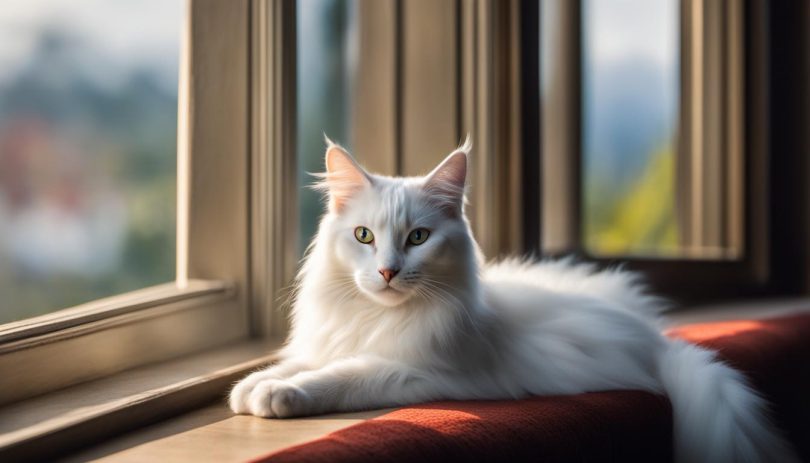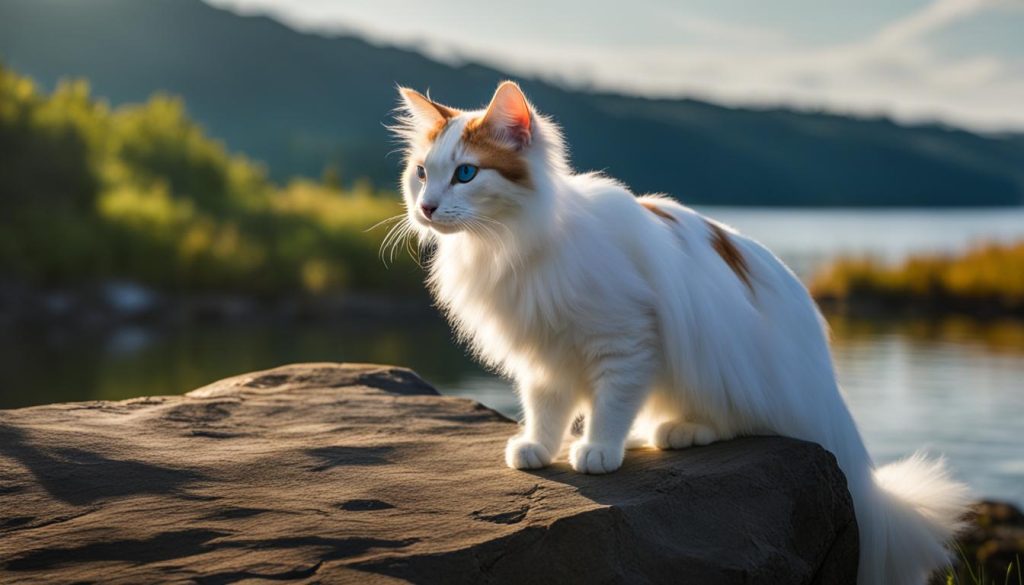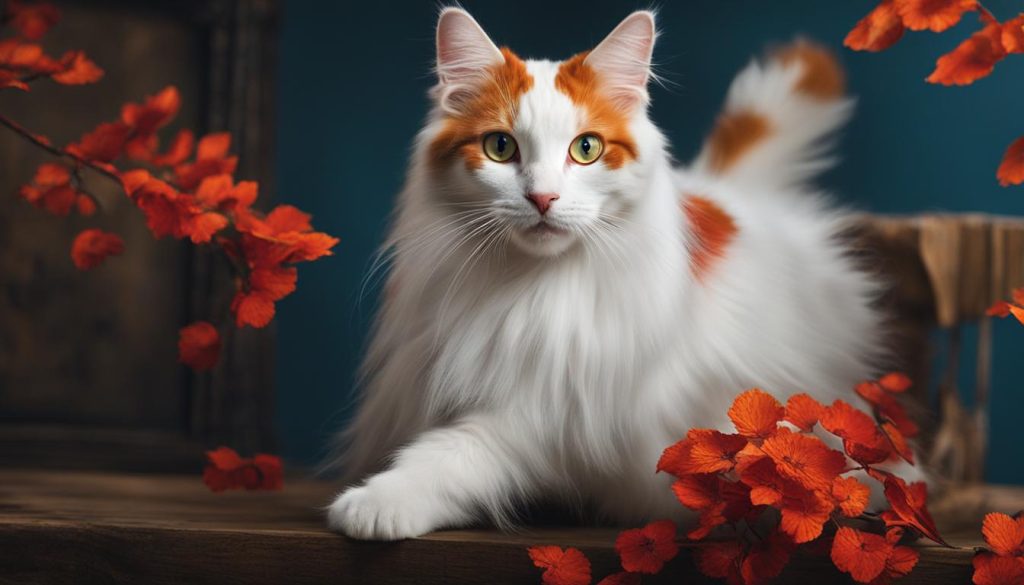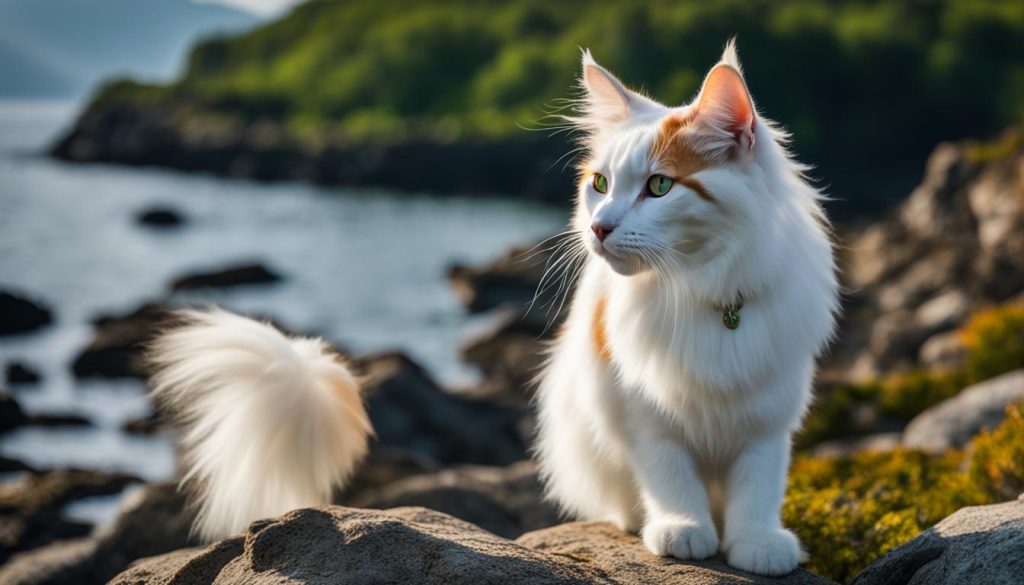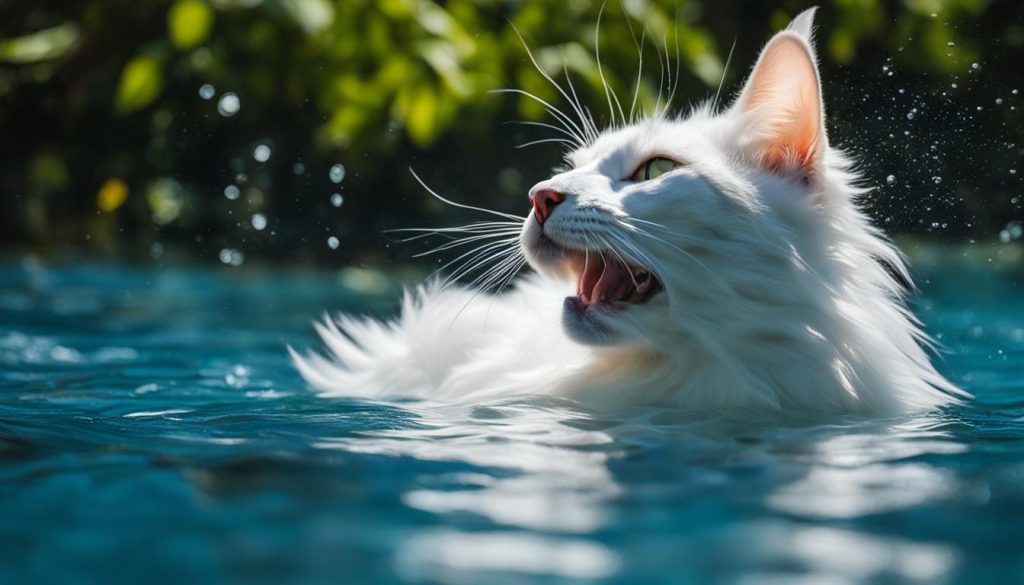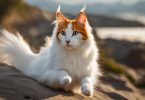Greetings! Today, I want to introduce you to a truly remarkable and extraordinary feline – the majestic White Turkish Van Cat. This exquisite cat breed is like no other, captivating the hearts of cat lovers worldwide. Known for its striking appearance and captivating characteristics, the Turkish Van cat is a breed that deserves our attention.
The Turkish Van cat, also known as the “Swimming Cat,” hails from the enchanting lands of southeast Turkey. Their allure lies in their distinctive coat pattern, with a pristine chalk-white body and colorful patches adorning their tail and head. This unique combination makes the Turkish Van cat a true work of art, adding to their beauty and charm.
Not only are Turkish Van cats visually stunning, but they also have a fascinating history. Legends surround their origins, with tales of Crusaders bringing them to Europe. It wasn’t until 1955 that Turkish Van cats made their way to the United Kingdom, and in 1982, they finally arrived in the United States. Despite their relatively recent introduction to the US, these majestic felines have quickly gained recognition and popularity among cat enthusiasts.
Let us delve deeper into the distinctive characteristics and captivating charm of the Turkish Van cat, a treasure waiting to be discovered and cherished.
Key Takeaways:
- The Turkish Van cat is a unique and captivating feline breed.
- Known for its white body and colorful patches on the tail and head.
- The Turkish Van cat has a fascinating history and is loved for its love of water.
- Originated in southeast Turkey, the breed has gained recognition and popularity worldwide.
- The Turkish Van cat’s distinctive appearance and playful nature make it a cherished companion.
Turkish Van Cats: An Intriguing Breed Origins
The Turkish Van cat is a fascinating and enigmatic breed with a rich history that remains shrouded in mystery. While the exact origins of this unique feline are uncertain, it is believed to have originated in southeast Turkey and parts of Iran, Iraq, and Russia. Some stories even suggest that Turkish Van cats were brought to Europe by Crusaders. Regardless of their exact origins, Turkish Van cats have made their mark on the world and have gained recognition and popularity in various countries.
In 1955, Turkish Van cats made their way to the United Kingdom, capturing the hearts of cat enthusiasts with their striking appearance and charming personality. Later, in 1982, they found their way to the United States, where they quickly garnered attention and admiration. Despite their relatively late arrival in the US, Turkish Van cats have become beloved and cherished pets for many families.
The unique origins of Turkish Van cats contribute to their allure and fascination. Their mysterious beginnings, coupled with their captivating appearance, make them a breed that stands out among others. Whether they descended from ancient cats of the region or were introduced by early travelers, Turkish Van cats truly embody the enigmatic charm of their homeland.
Theories on Turkish Van Cat Origins
There are numerous theories surrounding the origins of the Turkish Van cat. Some believe that they are descendants of cats that lived in the region for centuries, while others speculate that they were brought to the area by traders or travelers. The unique coat pattern, with a predominantly white body and colored patches, is often attributed to natural mutations or adaptations to the local environment.
“The Turkish Van cat’s origins may forever remain a mystery, but their presence and impact on the world of feline enthusiasts are undeniable.”
Regardless of their exact origins, Turkish Van cats have won the hearts of many with their beauty, charm, and distinct personality. Their journey from mysterious beginnings to becoming a cherished and recognized breed showcases their enduring legacy and appeal.
Turkish Van Cats: Distinctive Characteristics
Turkish Van cats are renowned for their unique appearance, showcasing distinctive characteristics that set them apart from other cat breeds. Their coat is predominantly chalk-white, creating a stunning contrast against the colored patches that are limited to the tail and head. These color markings can vary, including shades of red, cream, black, or blue, and even the presence of tabby patterns within these areas is allowed.
What truly adds to the allure of Turkish Van cats is the texture of their coat, which is soft and cashmere-like to the touch. This luxurious feel enhances their enchanting charm. Additionally, their tail has a brush-like appearance, further accentuating their elegance and grace.
When it comes to their physical structure, Turkish Van cats possess a sturdy and well-proportioned body. They have broad shoulders that exude strength and agility. What stands out most are their captivating eye colors, which can range from the mesmerizing hues of amber to the piercing depths of blue, and sometimes even both colors can be present in the same cat.
The Distinctive Characteristics of Turkish Van Cats at a Glance:
| Distinctive Attribute | Characteristic |
|---|---|
| Coat Color | Chalk-white body with colored patches on the tail and head |
| Color Markings | Varying shades of red, cream, black, or blue, with tabby patterns allowed |
| Coat Texture | Soft and cashmere-like |
| Tail Appearance | Brush-like |
| Eye Colors | Amber, blue, or a combination of both |
| Body Structure | Sturdy and well-proportioned with broad shoulders |
These unique characteristics make Turkish Van cats truly captivating and irresistible companions, enchanting the hearts of those fortunate enough to experience their presence.
5 Fascinating Facts about Turkish Van Cats
Turkish Van cats are truly extraordinary felines, and they have many fascinating facts that set them apart from other cat breeds. Let’s explore five intriguing facts about Turkish Van cats:
- A Unique Piebald Gene: Turkish Van cats have a distinct coat pattern due to a unique piebald gene. This gene gives them their captivating chalk-white body with colored patches on the tail and head, creating a striking and beautiful appearance.
- A Love for Water: Unlike most cats, Turkish Vans have a strong affinity for water and are natural-born swimmers. They enjoy splashing around in shallow pools or even joining their owners for a swim. Their love for water adds an extra dimension of uniqueness to their already enchanting personality.
- Distinct from Turkish Angoras: Turkish Van cats are often mistaken for Turkish Angoras, another beautiful breed originating from Turkey. However, they are two separate breeds with different characteristics. While Turkish Angoras have a silky white coat, Turkish Vans have the distinctive patterning on their bodies.
- The Van Pattern in Other Breeds: The unique Van pattern seen in Turkish Van cats is not exclusive to this breed. It can also be found in other cat breeds, although it is most commonly associated with Turkish Vans. This pattern adds to their allure and uniqueness.
- A Rare and Unique Breed: Turkish Van cats are considered a rare breed, ranking low in popularity among recognized cat breeds. Their unique characteristics, mesmerizing appearance, and affinity for water make them a treasure waiting to be discovered by those who appreciate their distinct charm.
These fascinating facts highlight the extraordinary nature of Turkish Van cats. Their unique coat pattern, love for water, and rarity among cat breeds make them truly one-of-a-kind feline companions.
With their mesmerizing appearance and playful personality, Turkish Van cats have the power to captivate the hearts of cat lovers. Whether you’re drawn to their distinct coat pattern or fascinated by their love for water, Turkish Van cats offer a combination of beauty and charm that is truly captivating.
The Rarity of Turkish Van Cats
Turkish Van cats are considered a rare breed due to their unique characteristics and low popularity among recognized cat breeds. Finding a purebred Turkish Van cat in a shelter or casually on the streets is highly unlikely. While there may be cats that resemble Turkish Vans, they are not considered true Turkish Vans without proper registration from an ethical breeder. However, these lookalike cats can still be unique and make wonderful companions.
The Rarity of Turkish Van Cats
Turkish Van cats are known for their distinct coat pattern, with a chalk-white body and colored patches on the tail and head. This unique appearance makes them captivating and beautiful. However, their rarity goes beyond their striking looks. Turkish Van cats are a breed that is not commonly found in shelters or as stray cats. To obtain a purebred Turkish Van, one must seek out a reputable breeder who can provide proper registration and documentation.
Due to their low popularity among recognized cat breeds, Turkish Van cats are not readily available. The demand for these felines is often much higher than the supply, further contributing to their rarity. While this may make them more challenging to find, it also adds to their allure and exclusivity.
Uniqueness and Exclusivity
Despite the rarity of Turkish Van cats, it’s important to note that lookalike cats with similar coat patterns can still be found in shelters or rescue organizations. These cats may have a white body with colored patches on the tail and head, resembling Turkish Vans. Although they may not be purebred Turkish Vans, they can still possess unique and charming traits.
Adopting a lookalike cat can provide a beautiful companion that shares some of the visual features of a Turkish Van. While they may not have the same lineage or pedigree, they can still bring joy, love, and companionship to their owners. It’s crucial to recognize the individuality of each cat and appreciate their own distinct qualities.
| Table: Characteristics of Turkish Van Cats and Lookalikes | |
|---|---|
| Turkish Van Cats | Lookalikes |
| Highly sought-after breed | May resemble Turkish Vans |
| Distinct coat pattern | Similar coat pattern |
| Possess unique traits | May have their own unique qualities |
| Registered and purebred | Not considered purebred Turkish Vans |
| Rare and exclusive | Can still be one-of-a-kind companions |
While purebred Turkish Van cats may be rare and harder to find, the existence of lookalikes provides an opportunity to appreciate and enjoy the beauty of cats with similar traits. Each cat, whether a Turkish Van or a lookalike, has its own unique personality and qualities that make them special in their own right.
The Adoption and Recognition of Turkish Van Lookalikes
While not true Turkish Van cats, lookalikes with similar coat patterns can be found in shelters or rescue organizations. These cats can have a white body with colored tail and head patches, resembling Turkish Vans. Adopting a lookalike can provide a beautiful companion with a touch of the Turkish Van’s exotic appearance.
It’s important to recognize the unique identity of Turkish Van cats and ensure the well-being of these special cats. Turkish Van lookalikes may share some physical characteristics with the breed, but they may not possess all the distinct qualities and traits that make Turkish Vans truly unique.
| Table 1: Comparison between Turkish Van Cats and Lookalikes | Turkish Van Cats | Lookalikes |
|---|---|---|
| Coat | Distinctive chalk-white body with colored patches limited to the tail and head. | Similar coat pattern, but may have variations in color or markings. |
| Physical Features | Brush-like tail, broad shoulders, and beautiful eye colors. | May have some resemblance to Turkish Van features, but not as pronounced or consistent. |
| Temperament | Playful, affectionate, and may show a strong affinity for water. | Temperament can vary, as they are not a recognized breed. |
| Registration | Recognized as a distinct breed with pedigree documentation. | Not recognized as a specific breed and lacks pedigree documentation. |
While adopting a Turkish Van lookalike can provide a cat with similar physical attributes, it’s essential to understand that these cats may not possess all the characteristics and traits unique to Turkish Vans. Nevertheless, lookalikes can still make wonderful companions, bringing a touch of the Turkish Van’s exotic appearance into your home.
Adopting a Turkish Van Lookalike: Things to Consider
When considering adopting a Turkish Van lookalike, it’s important to keep the following factors in mind:
- Research and understand the specific needs and characteristics of Turkish Vans to ensure you can provide a suitable environment for a similar-looking cat.
- Consult with reputable shelters or rescue organizations that have experience with Turkish Van lookalikes.
- Consider the cat’s overall health, temperament, and compatibility with your lifestyle and household.
- Provide proper care, enrichment, and regular veterinary check-ups to ensure the well-being of your adopted lookalike.
Adopting a Turkish Van lookalike can be a rewarding experience, giving a deserving cat a loving home. While they may not be true Turkish Vans, their resemblance can still bring joy and beauty into your life.
Turkish Van Cats: An Enduring Legacy
Turkish Van cats have a rich and enduring legacy that stretches back centuries. They are not just ordinary feline companions but a vital part of Turkish culture and history. In their native land of Turkey, Turkish Van cats are considered a national treasure and are protected as a precious breed.
The deep cultural importance of Turkish Van cats is evident in various aspects of Turkish folklore and traditions. These magnificent cats have been depicted in ancient Turkish artworks and have been celebrated in stories and legends passed down through generations. The enduring legacy of Turkish Van cats serves as a testament to their significance in Turkish society.
Furthermore, Turkish Van cats’ unique characteristics have contributed to their cultural importance. Their distinctive coat pattern and striking appearance have captured the imagination of many, making them a symbol of elegance and beauty. Their love for water, which is uncommon among cats, has also become part of their mystique, adding to their allure and charm.
As we delve deeper into the captivating world of Turkish Van cats, we not only discover a breed with fascinating history and extraordinary features but also a breed that carries the weight of cultural heritage and national pride. Turkish Van cats truly are a breed to be cherished and celebrated for their enduring legacy in Turkish culture and the hearts of cat enthusiasts worldwide.
Table: Turkish Van Cats in Turkish Culture
| Aspect | Description |
|---|---|
| Symbol of Elegance | Turkish Van cats’ unique coat pattern and striking appearance make them symbols of elegance and beauty in Turkish culture. |
| Cultural Artifacts | These magnificent cats have been featured in ancient Turkish artworks, showcasing their significance in Turkish history and art. |
| Legends and Folklore | Turkish Van cats have been celebrated in stories and legends passed down through generations, further solidifying their place in Turkish folklore. |
| Protected Breed | In Turkey, Turkish Van cats are recognized as a national treasure and are protected as a precious breed. |
Turkish Van Cats and Their Love for Water
Turkish Van cats are truly unique in their affinity for water. Unlike most cats, they are natural-born swimmers and take great pleasure in splashing and frolicking in water. This exceptional trait sets them apart from other feline breeds and adds to their allure. Whether it’s playfully batting at water droplets or taking a refreshing dip in a shallow pool, Turkish Van cats bring a splash of excitement and charm to any water-related activity.
It is believed that the Turkish Van’s love for water stems from their historical origins in the warm climates of Southeast Turkey and the surrounding regions. These areas are known for their humid summers, where natural water sources such as lakes and rivers are abundant. Over time, Turkish Van cats developed a strong affinity for water, which is now deeply ingrained in their instincts and behavior.
Owners of Turkish Van cats often find themselves amused and astonished by their feline companions’ fondness for aquatic adventures. Their water-loving nature can manifest in various ways, from hopping into the shower with their human to curiously observing fish in a home aquarium. The sight of a Turkish Van cat elegantly swimming through the water is truly a sight to behold.
| Water Activities Loved by Turkish Van Cats | Description |
|---|---|
| Playing with water bowls | Turkish Van cats enjoy dipping their paws into water bowls and splashing the water around as if engaged in a playful game. |
| Exploring water sources | They are known to be curious explorers, finding their way to faucets or natural water sources, and might even attempt to take a sip or a dip. |
| Swimming in pools | Many Turkish Van cats have been seen taking swimming adventures in pools, sometimes even joining their human counterparts for a refreshing swim. |
| Playing with water streams | They avidly chase and play with streams of water from faucets or fountains, a behavior that can be highly entertaining to witness. |
If you’re considering welcoming a Turkish Van cat into your home, it’s important to provide them with opportunities to satisfy their love for water. This can include providing shallow water bowls for them to play with or even setting up a small pool or fountain in a secure outdoor area. Ensuring their safety is paramount, and it’s essential to supervise any water-related activities to prevent accidents.
The Turkish Van’s affinity for water adds an extra layer of fascination to an already captivating breed. Their playful and adventurous nature, coupled with their love for water, makes them truly unique and enchanting companions.
Unveiling the Enigmatic Charms of Turkish Van Cats
Turkish Van cats are truly a unique feline breed that captivates with their distinctive characteristics. Their striking appearance, with a chalk-white body and colored patches on the tail and head, sets them apart from other cats. The Turkish Van’s love for water is another intriguing aspect that adds to their enigmatic charm. Whether it’s splashing in shallow pools or gracefully swimming, Turkish Van cats bring a touch of playfulness and excitement to water-related activities.
Aside from their physical attributes, Turkish Van cats possess a captivating personality. They are known for their affectionate and sociable nature, often forming strong bonds with their human companions. With their playful and energetic disposition, Turkish Van cats are always ready to engage in interactive games and provide hours of entertainment.
Furthermore, Turkish Van cats have a reputation for being smart and curious. They have a natural curiosity that leads them to explore their surroundings and investigate new things. Their intelligence combined with their love for water makes them fascinating companions who can provide endless surprises and amusement.
The Allure of Turkish Van Cats – A Closer Look
Let’s take a closer look at the unique characteristics that make Turkish Van cats so enchanting:
- Distinctive Coat: The Turkish Van’s coat is predominantly white, with colored patches limited to the tail and head. The variations in color markings and patterns make each Turkish Van cat truly one-of-a-kind.
- Water-Loving Nature: Unlike most cats, Turkish Vans have an exceptional affinity for water. They are natural swimmers and delight in splashing and playing in water.
- Affectionate and Energetic: Turkish Van cats are known for their loving and lively personality. They enjoy human company and thrive in households where they receive ample attention and playtime.
- Intelligent and Curious: Turkish Van cats are intelligent creatures with a curious nature. They love exploring their environment and are quick to learn new tricks and games.
In conclusion, Turkish Van cats possess a unique allure that sets them apart from other feline breeds. Their distinctive coat, love for water, and charming personality make them a fascinating companion for any cat lover. Unlocking the enigmatic charms of Turkish Van cats reveals a world of elegance, playfulness, and mystique that is sure to capture the hearts of all who encounter them.
Conclusion
Turkish Van cats are truly remarkable and extraordinary felines. Their unique coat pattern, love for water, and intriguing history make them an exclusive breed worth exploring. Whether you’re a proud owner or simply fascinated by these majestic cats, Turkish Van cats have an allure that transcends the ordinary. They embody grace, mystery, and elegance, captivating the hearts of all who encounter them. Turkish Van cats are a treasure waiting to be discovered and cherished.
FAQ
What is the origin of the Turkish Van cat?
The Turkish Van cat is believed to have originated in southeast Turkey and parts of Iran, Iraq, and Russia.
What makes the Turkish Van cat’s coat pattern unique?
The Turkish Van cat has a chalk-white body with colored patches limited to the tail and head.
Are Turkish Van cats rare?
Yes, Turkish Van cats are considered a rare breed.
Do Turkish Van cats enjoy swimming?
Yes, Turkish Van cats have a strong affinity for water and often enjoy swimming.
Are Turkish Van cats and Turkish Angoras the same breed?
No, Turkish Van cats and Turkish Angoras are two separate breeds.
